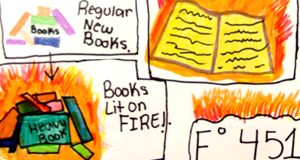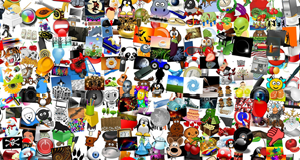Create a Creature
Students apply what they have learned about animal characteristics and adaptation to create a new creature and introduce it to the scientific community.

Task
Scientists are finding new species every year. While some of them live in remote environments, others have been found in large urban cities! While you can’t travel to faraway lands in the hopes of finding a new species, you can use what you know about plant and animal adaptation to create a new species of your own!
Create an electronic book to introduce your species to the world, sharing its physical adaptations, daily habits (behavioral adaptations), predators, and prey.
Engage
There are lots of right ways to explore this topic. You might focus on a specific habitat and brainstorm animals and adaptations for that habitat. You might instead have students individually or collaboratively research a favorite animal and explore its habitat and adaptations. This “create a creature” project is a good culminating assessment of student understanding of animals, habitats, and adaptations and assumes they have already explored these topics.
Begin project work by reading about one of the amazing creatures in Extreme Animals: The Toughest Creatures on Earth by Nicola Davies. This book is filled with remarkable information about many animals kids are familiar with. Share additional photos of the animal with your students from education-friendly sites like Pics4Learning.com. Penguins are a perennial favorite with elementary students and images, leveled literature, and information texts abound.
Ask your students to share what they know about other amazing creatures. Help lead students to the realization that a unique physical or behavioral adaptation is what makes the animal interesting. To get them talking, ask students to share:
- What the animal looks like.
- Where the animal lives in the wild.
- What makes it interesting.
Explain that new plants and animals are still being discovered by scientists and researchers. Share examples of some of newly-discovered species with your students. Live Science has a collection of some great examples for 2013; a search on the Web will turn up many others.
Let students know that they will become animal explorers tasked with a mission to “find” a new species. They will use what they have learned about plant and animal characteristics and adaptations to create a new species and introduce it to the world by creating an electronic book.
Create
Depending on the culture and students in your classroom, students may work individually or in small groups. If you have highly independent learners, let them show off their individuality through personal work. If you have students who must collaborate to come up with ideas, small teams provide many more opportunities to discuss and process learning. Group work also provides additional opportunities for you to identify misconceptions and help the group to focus on key understandings.
If your students have a strong grasp of characteristics, adaptations, and habitats, have students or teams begin by describing the habitat in which their new animal will live. They should include information about weather, temperature, rainfall, plants, and other animals.
Next, have students think about where their animal will live in this habitat – on the ground, in the air, water, or tree tops, etc. Share graphic organizers like t-charts, 4-squares, clusters, and storyboards to help students organize their ideas.
Ask students to create a creature with adaptations that help it survive in this environment. Encourage them to look to other creatures in similar habitats to identify features and characteristics that would help this creature thrive in its habitat. If they are creative thinkers, they can simply start designing.
If your students are just beginning to understand the idea of adaptations, have them create a creature first by combining body parts from one or more categories of animal types, including birds, reptiles, amphibians, fish, insects, and invertebrates.
Tell your students they will be introducing their amazing creatures to the world. Use a tool like Wixie to have them combine text, images, and voice narration to create a report, slide deck, or even digital book.
Books should include the features of informational text, including images, labels, photos, captions, and headings. The information students provide should answer questions like:
- What are the physical features of this creature?
- Why are these features needed in this habitat?
- What does this creature eat?
- What does this creature do during the day? Or is it nocturnal?
- Does this creature have any natural predators?
If your students are ready, give them flexibility to choose the information they will include in their project. If you want to provide direction and structure to the project, you could ask students to create a project that includes pages for:
- Title page with name of animal and scientist(s) who discovered it
- Image of create in habitat
- Description of habitat and images to support description
- Description of creature’s characteristics and image with labels
- Description of creature’s predators and prey (diet)
- Story of how the creature was discovered (narrative writing)
Have students record their voices as they read the information on each page. (Note that audio for ePub may not work on all Android devices.)
Share
Have students present their creatures to the rest of the class or to a different team. To give the project an additional air of authenticity, bring in local experts to ask questions and evaluate student work. If you do not have a local zoo, veterinarians, park rangers, and even pet enthusiast parents may be willing to help.
Students can publish their books as ePub files and share them using a service like iTunes or Dropbox. Share the ePubs in the school library database, on computers in the library, or in a publically accessible network location where other students can access and download the publications.
If you don’t have ready access to eReaders, you can export the finished work as PDF files for easy sharing. You can also print their work and share it in classroom and school media centers or post the digital files to your classroom web site.
Assessment
The final ePub and the work during the process will help you evaluate student understanding of animals, habitats, and adaptations.
As individual students or teams begin working on the descriptions of their habitats and animal features, monitor their progress and ask questions. You can also use graphic organizers as tangible check in points.
As students begin illustrating, prompt them with questions about their animals to encourage them to add more details and create accurate illustrations.
The resulting ePub or PDF can serve as an artifact for summative assessment of content and expository, or informative, writing. If their work includes a story detailing the discovery of the creature, you can also evaluate their narrative writing skills.
Be sure to evaluate oral presentations for content accuracy. Students’ ability to answer questions from the audience will help you assess how well they have internalized the concepts of behavioral and physical adaptations.
Resources
Nicola Davies. Extreme Animals: The Toughest Creatures on Earth. ISBN: 0763641278
Pamela Hickman. Animals in Motion: How Animals Swim, Jump, Slither and Glide. ISBN: 1550745751
National Park Service: Our Wild Neighbors
Standards
Next Generation Science Standards
3-LS3-2 Heredity: Inheritance and Variation of Traits
Use evidence to support the explanation that traits can be influenced by the environment.
3-LS4-3 Biological Evolution: Unity and Diversity
Construct an argument with evidence that in a particular habitat some organisms can survive well, some survives less well, and some cannot survive at all.
Common Core State Standards for English Language Arts
CCSS.ELA-LITERACY.RI.3.1
Ask and answer questions to demonstrate understanding of a text, referring explicitly to the text as the basis for the answers.
CCSS.ELA-LITERACY.RI.3.4
Determine the meaning of general academic and domain-specific words and phrases in a text relevant to a grade 3 topic or subject area.
CCSS.ELA-LITERACY.RI.3.5
Use text features and search tools (e.g., key words, sidebars, hyperlinks) to locate information relevant to a given topic efficiently.
CCSS.ELA-LITERACY.W.3.2
Write informative/explanatory texts to examine a topic and convey ideas and information clearly.
CCSS.ELA-LITERACY.W.3.6
With guidance and support from adults, use technology to produce and publish writing (using keyboarding skills) as well as to interact and collaborate with others.
ISTE NETS for Students 2016:
3. Knowledge Constructor
Students critically curate a variety of resources using digital tools to construct knowledge, produce creative artifacts and make meaningful learning experiences for themselves and others. Students:
a. plan and employ effective research strategies to locate information and other resources for their intellectual or creative pursuits.
6. Creative Communicator
Students communicate clearly and express themselves creatively for a variety of purposes using the platforms, tools, styles, formats and digital media appropriate to their goals. Students:
a. choose the appropriate platforms and tools for meeting the desired objectives of their creation or communication.
b. create original works or responsibly repurpose or remix digital resources into new creations.
c. communicate complex ideas clearly and effectively by creating or using a variety of digital objects such as visualizations, models or simulations.
d. publish or present content that customizes the message and medium for their intended audiences.













